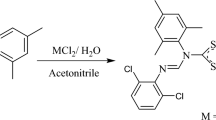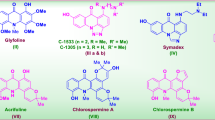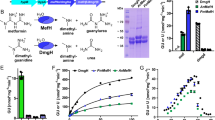Abstract
Here we report the structure of acireductone dioxygenase (ARD), the first determined for a new family of metalloenzymes. ARD represents a branch point in the methionine salvage pathway leading from methylthioadenosine to methionine and has been shown to catalyze different reactions depending on the type of metal ion bound in the active site. The solution structure of nickel-containing ARD (Ni-ARD) was determined using NMR methods. X-ray absorption spectroscopy, assignment of hyperfine shifted NMR resonances and conserved domain homology were used to model the metal-binding site because of the paramagnetism of the bound Ni2+. Although there is no structure in the Protein Data Bank within 3 Å r.m.s deviation of that of Ni-ARD, the enzyme active site is located in a conserved double-stranded b-helix domain. Furthermore, the proposed Ni-ARD active site shows significant post-facto structural homology to the active sites of several metalloenzymes in the cupin superfamily.
This is a preview of subscription content, access via your institution
Access options
Subscribe to this journal
Receive 12 print issues and online access
$259.00 per year
only $21.58 per issue
Buy this article
- Purchase on SpringerLink
- Instant access to full article PDF
Prices may be subject to local taxes which are calculated during checkout






Similar content being viewed by others
Accession codes
References
Al-Lazikani, B., Jung, J., Xiang, Z.X. & Honig, B. Protein structure prediction. Curr. Opin. Chem. Biol. 5, 51–56 (2001).
Ko, T.P., Day, J. & Mcpherson, A. The refined structure of canavalin from jack bean in two crystal forms at 2. 1 and 2.0 Å resolution. Acta Crystallogr. D 56, 411–420 (2000).
Dunwell, J.M., Culham, A., Carter, C.E., Sosa-Aguirre, C.R. & Goodenough, P.W. Evolution of functional diversity in the cupin superfamily. Trends Biochem. Sci. 26, 740–746 (2001).
Al-Mjeni, F., Ju, T., Pochapsky, T.C. & Maroney, M.J. XAS investigation of the structure and function of Ni in acireductone dioxygenase. Biochemistry 41, 6761–6769 (2002).
Anand, R., Dorrestein, P.C., Kinsland, C., Begley, T.P. & Ealick, S.E. Structure of oxalate decarboxylase from Bacillus subtilis at 1.75 Å resolution. Biochemistry 41, 7659–7669 (2002).
Woo, E.J., Dunwell, J.M., Goodenough, P.W., Marvier, A.C. & Pickersgill, R.W. Germin is a manganese containing homohexamer with oxalate oxidase and superoxide dismutase activities. Nature Struct. Biol. 7, 1036–1040 (2000).
Wray, J.W. & Abeles, R.H. A bacterial enzyme that catalyzes formation of carbon-monoxide. J. Biol. Chem. 268, 21466–21469 (1993).
Dai, Y., Wensink, P.C. & Abeles, R.H. One protein, two enzymes. J. Biol. Chem. 274, 1193–1195 (1999).
Kestell, P. in Biological Interactions of Sulfur Compounds. (ed. Mitchell, S.) 190–196 (Taylor & Francis, London; 1996).
Balakrishnan, R., Frohlich, M., Rahaim, P.T., Backman, K. & Yocum, R.R. Cloning and sequence of the gene encoding enzyme E1 from the methionine salvage pathway of Klebsiella oxytoca. J. Biol. Chem. 268, 24792–24795 (1993).
Myers, R.W., Wray, J.W., Fish, S. & Abeles, R.H. Purification and characterization of an enzyme involved in oxidative carbon-carbon bond cleavage reactions in the methionine salvage pathway of Klebsiella pneumoniae. J. Biol. Chem. 268, 24785–24791 (1993).
Wray, J.W. & Abeles, R.H. The methionine salvage pathway in Klebsiella pneumoniae and rat liver — identification and characterization of 2 novel dioxygenases. J. Biol. Chem. 270, 3147–3153 (1995).
Dai, Y., Pochapsky, T.C. & Abeles, R.H. Mechanistic studies of two dioxygenases in the methionine salvage pathway of Klebsiella pneumoniae. Biochemistry 40, 6379–6387 (2001).
Dai, Y. Subcloning, expression, characterization and mechanistic studies of two dioxygenases in the methionine pathways. Ph.D. thesis, Brandeis Univ. (1998).
Mo, H.P., Dai, Y., Pochapsky, S.S. & Pochapsky, T.C. 1H, 13C and 15N NMR assignments for a carbon monoxide generating metalloenzyme from Klebsiella pneumoniae. J. Biomol. NMR 14, 287–288 (1999).
Marchler-Bauer, A. et al. CDD: a database of conserved domain alignments with links to domain three-dimensional structure. Nucleic Acids Res 30, 281–283 (2002).
Altschul, S. et al. Gapped BLAST and PSI-BLAST: a new generation of protein database search programs. Nucleic Acids Res. 25, 3389–3402 (1997).
Pochapsky, T.C. & Gopen, Q. A chromatographic approach to the determination of relative free energies of interaction between hydrophobic and amphiphilic amino acid side chains. Protein Sci. 1, 786–795 (1992).
De Araujo, A.F.P., Pochapsky, T.C. & Joughin, B. Thermodynamics of interactions between amino acid side chains: experimental differentiation of aromatic-aromatic, aromatic- aliphatic, and aliphatic-aliphatic side-chain interactions in water. Biophys. J. 76, 2319–2328 (1999).
Christendat, D. et al. Crystal structure of DTDP-4-keto-5-deoxy-D-hexulose 3,5-epimerase from Methanobacterium thermoautotrophicum complexed with DTDP. J. Biol. Chem. 275, 24608–24612 (2000).
Gibrat, J.-F., Madej, T. & Bryant, S.H. Surprising similarities in structure comparison. Curr. Opin. Struct. Biol. 6, 377–385 (1996).
Madej, T., Gibrat, J.-F. & Bryant, S.H. Threading a database of protein cores. Proteins 23, 356–369 (1995).
Gane, P.J., Dunwell, J.M. & Warwicker, J. Modeling based on the structure of vicilins predicts a histidine cluster in the active site of oxalate oxidase. J. Mol. Evol. 46, 488–493 (1998).
Pochapsky, T.C., Ye, X.M., Ratnaswamy, G. & Lyons, T.A. An NMR-derived model for the solution structure of oxidized putidaredoxin, a 2Fe, 2S ferredoxin from Pseudomonas. Biochemistry 33, 6424–6432 (1994).
Pochapsky, T.C., Jain, N.U., Kuti, M., Lyons, T.A. & Heymont, J. A refined model for the solution structure of oxidized putidaredoxin. Biochemistry 38, 4681–4690 (1999).
Muhandiram, D.R., Farrow, N.A., Xu, G.Y., Smallcombe, S.H. & Kay, L.E. A gradient 13C NOESY-HSQC experiment for recording NOESY spectra of 13C-labeled proteins dissolved in H2O. J. Magn. Reson. B 102, 317–321 (1993).
Marion, D., Kay, L.E., Sparks, S.W., Torchia, D.A. & Bax, A. 3-dimensional heteronuclear NMR of 15N-labeled proteins. J. Am. Chem. Soc. 111, 1515–1517 (1989).
Bax, A. & Pochapsky, S.S. Optimized recording of heteronuclear multidimensional NMR spectra using pulsed field gradients. J. Magn. Reson. 99, 638–643 (1992).
Nilges, M., Clore, G.M. & Gronenborn, A.M. Determination of 3-dimensional structures of proteins from interproton distance data by dynamical simulated annealing from a random array of atoms — circumventing problems associated with folding. FEBS Lett. 239, 129–136 (1988).
Kuszewski, J. & Clore, G.M. Sources of and solutions to problems in the refinement of protein NMR structures against torsion angle potentials of mean force. J. Magn. Reson. 146, 249–254 (2000).
Kuszewski, J., Gronenborn, A.M. & Clore, G.M. Improvements and extensions in the conformational database potential for the refinement of NMR and X-ray structures of proteins and nucleic acids. J. Magn. Reson. 125, 171–177 (1997).
Kuszewski, J., Gronenborn, A.M., & Clore, G.M. Improving the quality of NMR and crystallographic protein structures by means of a conformational database potential derived from structure databases. Protein Sci. 5, 1067–1080 (1996).
Altschul, S.F., Gish, W., Miller, W., Myers, E.W. & Lipman, D.J. Basic local alignment search tool. J. Mol. Biol. 215, 403–410 (1990).
Yeh, C.T., Lai, H.Y., Chen, T.C., Chu, C.M. & Liaw, Y.F. Identification of a hepatic factor capable of supporting hepatitis C virus replication in a nonpermissive cell line. J. Virology 75, 11017–11024 (2001).
Koradi, R., Billeter, M. & Wuthrich, K. MOLMOL: a program for display and analysis of macromolecular structures. J. Mol. Graph. 14, 51–55 (1996).
Kraulis, P.J. Molscript — a program to produce both detailed and schematic plots of protein structures. J. Appl. Crystallogr. 24, 946–950 (1991).
Kelly, G.P., Muskett, F.W. & Whitford, D. 3D J-Resolved HSQC, a novel approach to measuring 3J(HN-Hα) application to paramagnetic proteins. J. Magn. Reson. B 113, 88–90 (1996).
Cornilescu, G., Delaglio, F. & Bax, A. Protein backbone angle restraints from searching a database for chemical shift and sequence homology. J. Biomol. NMR 13, 289–302 (1999).
Laskowski, R.A., Rullmann, J.A.C., Macarthur, M.W., Kaptein, R. & Thornton, J.M. AQUA and PROCHECK-NMR: programs for checking the quality of protein structures solved by NMR. J. Biomol. NMR 8, 477–486 (1996).
Acknowledgements
This work was supported by the U.S. Public Health Service. The 600 MHz NMR spectrometer used was purchased via a grant from the National Science Foundation (T.C.P.). The authors thank G. Wagner (Harvard Medical School) for access to his 750 MHz NMR spectrometer.
Author information
Authors and Affiliations
Corresponding author
Ethics declarations
Competing interests
The authors declare no competing financial interests.
Rights and permissions
About this article
Cite this article
Pochapsky, T., Pochapsky, S., Ju, T. et al. Modeling and experiment yields the structure of acireductone dioxygenase from Klebsiella pneumoniae. Nat Struct Mol Biol 9, 966–972 (2002). https://doi.org/10.1038/nsb863
Received:
Accepted:
Published:
Issue date:
DOI: https://doi.org/10.1038/nsb863
This article is cited by
-
Activation of a gene network in durum wheat roots exposed to cadmium
BMC Plant Biology (2018)
-
Oxygen activation by mononuclear Mn, Co, and Ni centers in biology and synthetic complexes
JBIC Journal of Biological Inorganic Chemistry (2017)
-
ADI1, a methionine salvage pathway enzyme, is required for Drosophila fecundity
Journal of Biomedical Science (2014)
-
An NMR structural study of nickel-substituted rubredoxin
JBIC Journal of Biological Inorganic Chemistry (2010)
-
Nickel superoxide dismutase: structural and functional roles of Cys2 and Cys6
JBIC Journal of Biological Inorganic Chemistry (2010)



